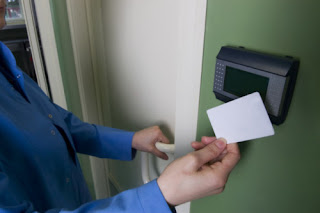HOW RFID WORKS FOR ACCESS CONTROL
Most access control systems now use a technology called Radio Frequency Identification or RFID.
RFID technology is combined into contactless smart cards which people use to identify themselves, and determine whether they should be able to access a building (or not).
Some of the benefits which RFID offers over the older technologies, such as magnetic stripe cards, is that there is no contact required between the reader and the card. This significantly reduces wear and tear on both the card and reader, requiring much less frequent replacement of card reader hardware.
However, cards still need to be protected ideally placing them in a plastic badge holder like the picture below to ensure that the card is not bent and damaged.
This article will focus on Passive RFID systems where there is no battery source within the card or credential, as these are more commonly used for access control systems.
HOW DOES IT WORK?
In an access control installation, the card reader is constantly emitting an RF Energy Field.
When a card crosses into the field, the power from the RF field energises an aerial of copper wire looped inside the card body, an example of which is shown in the image below.
This aerial is also connected to the smart card chip inside the card.
The aerial powers the chip which contains the card number and any other data contained on the card, such as unique customer or facility code.
The card number is then transmitted back to the reader using part of the RF field as a transmission method.
The reader will then send the card number to the access control system which will make a decision on whether the card holder is authorised to enter.
READ RANGE AND FREQUENCY
There are three different frequencies usually deployed within access control, sometimes these can be combined into a single reader, sometimes separate.
LOW FREQUENCY – 125KHZ
The most common card technology within the low frequency space is the HID Proximity card, operating at 125khz.
This frequency provides a good “hands free” read-range of up to 1 meter in ideal conditions, but can only transmit small amounts of data.
This makes it more suitable for access control purposes, because just the customer code and card number are transmitted which is relatively small.
MEDIUM FREQUENCY – 13.56MHZ
This is the most common frequency in use, and includes card technologies such as MIFARE, Legic Advant and other popular card types.
This frequency is also used for NFC used in mobile telephones to emulate smart cards.
This frequency provides a much shorter read range, typically around 30cm in optimal conditions and requires the card to be placed much closer to the reader.
It does however, offer a higher data transfer rate than low frequency technologies making it suitable for both proximity access control due to the shorter proximity read range, and data transactions due to the higher data throughput.
HIGH FREQUENCY 2.4GHZ
High Frequency is commonly used for vehicle access control due its ability to operate over greater distances – around 4 meters with a passive tag, or up to 10 meters with an active tag.
Whilst this frequency provides a much greater read range, the amount of data that can be transmitted is also greater, making it most suited for vehicle access control and closed parking solutions with data transactions possible up to 15 meters.
If you’re looking for guidance on access control, or need help with choosing the right technology for your project, please contact us on +86 13823761799(whatsApp & Wechat) or email: root@grcard.cn
Blog written by Ross Bale, Security Specialist at www.rossbale.com



评论
发表评论